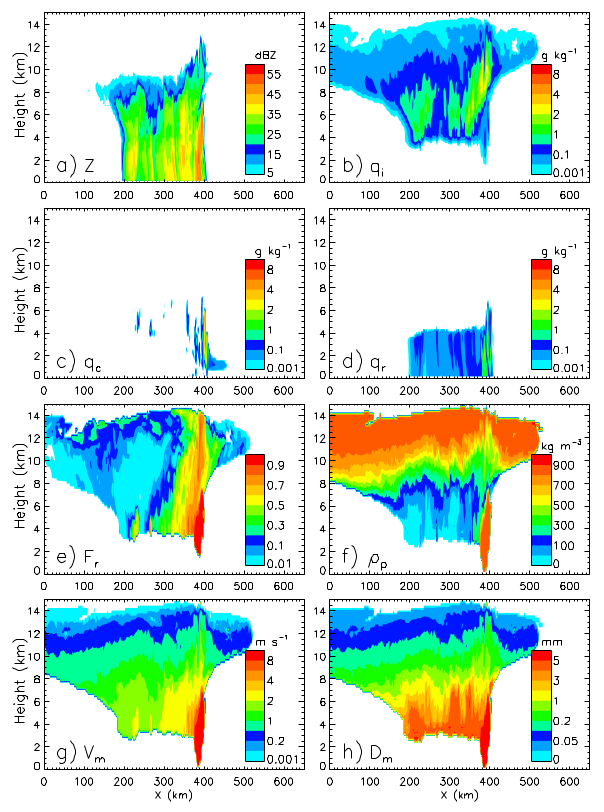A New Approach for Representing Ice Particles in Weather and Climate Model
Submitter
Morrison, Hugh Clifton — University Corporation for Atmospheric Research
Area of research
Cloud Processes
Journal Reference
Science
Proper representation of cloud microphysical and precipitation processes is critical for the simulation of weather and climate. Despite decades of advancement, the representation of cloud and precipitation particles in weather and climate models still has many uncertainties. This is due to an incomplete understanding of the important physical processes as well as the inherent complexity of these particles in the real atmosphere, especially ice particles. In order to represent the range of ice particles and their physical properties within the constraints of limited computational resources, current microphysical schemes use various hydrometeor categories defined by prescribed physical characteristics (e.g. shape, bulk density, fallspeed, etc.) that broadly describe a given “typical” particle type such as pristine ice, snow, graupel, or hail. The relative simplicity of this approach has been successful in some aspects of modeling but problematic for others. There is a large sensitivity of model simulations to how ice is partitioned into categories, and changes in thresholds or rates for conversion between ice categories can lead to substantial differences in simulations. For example, representing rimed ice with characteristics more like slower-falling graupel or faster-falling hail can have large impacts on the structure of simulated convective storms.
In recent years there has been a broader shift in the representation of ice microphysics by emphasizing the prediction of particle properties rather than the separation of ice into different pre-defined, fixed categories. In this study, the approach is generalized and a method is proposed to predict several bulk physical properties of ice particles such as mean density, size, rime mass fraction, and fallspeed, which can evolve through the full range of growth and decay processes including vapor deposition, riming, and aggregation, for a single ice "category". The proposed approach thus completely eliminates the need for artificial conversion between pre-defined ice categories. This forms the basis for a conceptually new bulk microphysics scheme, referred to as the Predicted Particle Properties (P3) scheme.
Impact
The P3 scheme is tested for both idealized and real case studies using the Weather Research and Forecasting model (WRF). Results are also compared with simulations using other microphysical schemes in WRF that employ the traditional approach of using fixed ice categories. P3 can produce a wide variety of particle characteristics despite having only one ice-phase “category” because it allows the ice particle properties to evolve in time and space. For a squall line simulation it produces dense, fast-falling, hail-like ice near convective updraft cores and lower density, slower-falling ice elsewhere (see plots). Sensitivity tests show this is critical for simulating high precipitation rates observed along the leading edge of the storm. For a case of frontal/orographic precipitation P3 produces areas of relatively fast-falling ice with characteristics of rimed snow and low- to medium-density graupel on the windward slope of the Cascade Range. This leads to less precipitation on leeward slopes, and more on windward slopes, compared to most of the other microphysics schemes.
Summary
Parameterizing ice-phase microphysical processes by predicting bulk particle properties in schemes such as P3, rather than partitioning ice into pre-defined categories, has several conceptual advantages by eliminating the need for artificial convection processes and allowing smooth variations in particle characteristics. It also allows closer coupling with observations because these physical properties can be measured, unlike many parameters in the traditional approach that are unphysical, such as conversion thresholds between pre-defined categories. The real-case simulations examined in this study suggest that P3 is also viable in terms of practical performance. Furthermore, the scheme is computationally efficient because it has fewer ice variables than most traditional schemes. However, it is emphasized that P3 must be tested on many more cases covering a wide range of conditions to evaluate its overall performance. Moreover, other aspects such as cloud cover and radiative fluxes should be investigated and compared with observations.


